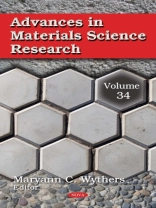Advances in Materials Science Research. Volume 34 begins with a review of results on the modelling of the plasma-assisted growth of vertically aligned carbon nanostructures (VACNs). Growth of carbon nanofibers, single-walled carbon nanotubes and other carbon nanostructures are considered, as well as studies that use the mechanistic models based on mass balance equations for species.Next, data on the application of Rayleigh and Mandelstam-Brillouin scattering (RMBS) spectroscopy to controlling the elastic, elasto-optic, optical parameters of inorganic glasses, crystals, and glass-crystalline materials is reviewed. The possibilities of using RMBS spectroscopy for research and development of materials for optical and electro-optical fiber drawing, as well as glasses doped with rare earth ions and quantum dots, are considered.The authors go on to propose that the purification of graphene from heavy metals can be performed by bombardment with noble gas clusters. The method of molecular dynamics is used to study the removal of copper, lead, and mercury from graphene by irradiating the target using a beam of Ar13 or Xe13 clusters with energies of 5-30 e V at angles of incidence 0A(deg), 45A(deg), 60A(deg), and 90A(deg).As an indispensable component of future flexible electronics, flexible resistive switching memories have recently garnered great interest globally. As such, a comprehensive review on the recent progress in this field is presented with a particular emphasis on materials and devices. A short discussion on the current challenges and future prospects of flexible resistive switching memories is also provided.Following this, the authors aim to present a comprehensive examination of the different catalysts used in hydroisomerization reactions, focusing: the acid support, mainly zeolites, the precious metals that offer the hydrogenating sites and the methodologies used to produce effective bifunctional catalysts. The catalysts used in industrial refining processes as well as new research trends are surveyed.A fast, efficient and versatile route for the synthesis of 4, 4′-diaminotriarylmethanes using Sr(DS)2 as a Lewis acid-surfactant-combined catalyst (LASCs) in the presence of N, N-dimethyl aniline and aryl aldehydes is reported in closing. LASCs not only act as a Lewis acid to activate substrate molecules, but also serve as a surfactant to form stable colloidal dispersion systems with organic substrates.
Maryann C Wythers
Advances in Materials Science Research. Volume 34 [PDF ebook]
Advances in Materials Science Research. Volume 34 [PDF ebook]
Achetez cet ebook et obtenez-en 1 de plus GRATUITEMENT !
Format PDF ● Pages 242 ● ISBN 9781536144246 ● Éditeur Maryann C Wythers ● Maison d’édition Nova Science Publishers, Inc. ● Publié 2018 ● Téléchargeable 3 fois ● Devise EUR ● ID 6890431 ● Protection contre la copie Adobe DRM
Nécessite un lecteur de livre électronique compatible DRM












